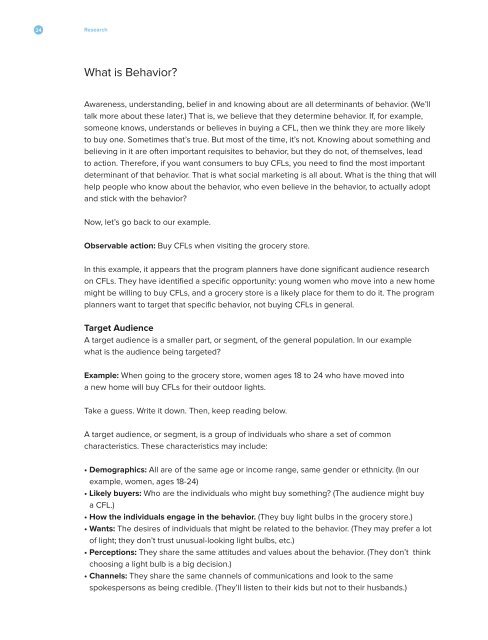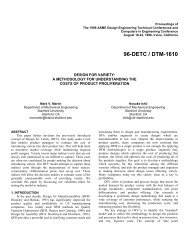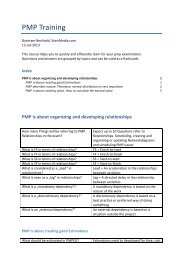Social Marketing
You also want an ePaper? Increase the reach of your titles
YUMPU automatically turns print PDFs into web optimized ePapers that Google loves.
24<br />
Research<br />
What is Behavior?<br />
Awareness, understanding, belief in and knowing about are all determinants of behavior. (We’ll<br />
talk more about these later.) That is, we believe that they determine behavior. If, for example,<br />
someone knows, understands or believes in buying a CFL, then we think they are more likely<br />
to buy one. Sometimes that’s true. But most of the time, it’s not. Knowing about something and<br />
believing in it are often important requisites to behavior, but they do not, of themselves, lead<br />
to action. Therefore, if you want consumers to buy CFLs, you need to find the most important<br />
determinant of that behavior. That is what social marketing is all about. What is the thing that will<br />
help people who know about the behavior, who even believe in the behavior, to actually adopt<br />
and stick with the behavior?<br />
Now, let’s go back to our example.<br />
Observable action: Buy CFLs when visiting the grocery store.<br />
In this example, it appears that the program planners have done significant audience research<br />
on CFLs. They have identified a specific opportunity: young women who move into a new home<br />
might be willing to buy CFLs, and a grocery store is a likely place for them to do it. The program<br />
planners want to target that specific behavior, not buying CFLs in general.<br />
Target Audience<br />
A target audience is a smaller part, or segment, of the general population. In our example<br />
what is the audience being targeted?<br />
Example: When going to the grocery store, women ages 18 to 24 who have moved into<br />
a new home will buy CFLs for their outdoor lights.<br />
Take a guess. Write it down. Then, keep reading below.<br />
A target audience, or segment, is a group of individuals who share a set of common<br />
characteristics. These characteristics may include:<br />
• Demographics: All are of the same age or income range, same gender or ethnicity. (In our<br />
example, women, ages 18-24)<br />
• Likely buyers: Who are the individuals who might buy something? (The audience might buy<br />
a CFL.)<br />
• How the individuals engage in the behavior. (They buy light bulbs in the grocery store.)<br />
• Wants: The desires of individuals that might be related to the behavior. (They may prefer a lot<br />
of light; they don’t trust unusual-looking light bulbs, etc.)<br />
• Perceptions: They share the same attitudes and values about the behavior. (They don’t think<br />
choosing a light bulb is a big decision.)<br />
• Channels: They share the same channels of communications and look to the same<br />
spokespersons as being credible. (They’ll listen to their kids but not to their husbands.)

















